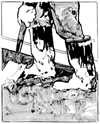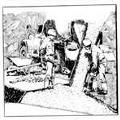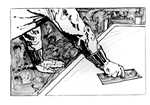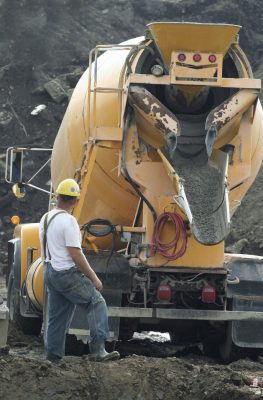From the Portland Cement Association:
Working Safely with Concrete
Concrete is easy to work with, versatile, durable, and economoicl. By taking a few basic precautions, it is also one of the safest building materials known. Relatively few people involved in mixing, handling, and finishing concrete have experienced injury.
Outlined below are some simple suggestions-protection, prevention, common sense precautions-useful to anyone working with portland cement and concrete. Workers should also consult the last information from the U.S. Department of Labor at www.osha.gov.
Protect Your Head and Eyes

Construction equipment and tools represent constant potential hazards to busy construction personnel. That’s why hard hats are required on construction projects. It is therefore recommended that some sort of head protection, such as a hard hat or safety hat, be worn when working any construction job, large or small.
Proper eye protection is essential when working with cement or concrete. Eyes are particularly vulnerable to blowing dust, splattering concrete, and other foreign objects. On some jobs it may be advisable to wear full-cover goggles or safety glasses with side shields. Sight is precious. Protect the head and eyes by using proper safety equipment and remaining alert.
Protect Your Back
 All materials used to make concrete—portland cement, coarse aggregate, sand, and water—are quite heavy even in small quantities. When lifting heavy materials, your back should be straight, legs bent, and the weight between your legs as close to the body as possible. Do not twist at the waist while lifting or carrying these items. Rather than straining your back with a heavy load, get help. Remember to use your head, not your back.
All materials used to make concrete—portland cement, coarse aggregate, sand, and water—are quite heavy even in small quantities. When lifting heavy materials, your back should be straight, legs bent, and the weight between your legs as close to the body as possible. Do not twist at the waist while lifting or carrying these items. Rather than straining your back with a heavy load, get help. Remember to use your head, not your back.
Let mechanical equipment work to your advantage by placing concrete as close as possible to its final position. After the concrete is deposited in the desired area by chute, pump, or wheelbarrow, it should be pushed—not lifted—into final position with a shovel. A short-handled, square-end shovel is an effective tool for spreading concrete, but special concrete rakes or come-alongs also can be used. Excessive horizontal movement of the concrete not only requires extra effort, but may also lead to segregation of the concrete ingredients.
Protect Your Skin
 When working with fresh concrete, care should be taken to avoid skin irritation or chemical burns. Prolonged contact between fresh concrete and skin surfaces, eyes, and clothing may result in burns that are quite severe, including third-degree burns. If irritation persists consult a physician. For deep burns or large affected skin areas, seek medical attention immediately.
When working with fresh concrete, care should be taken to avoid skin irritation or chemical burns. Prolonged contact between fresh concrete and skin surfaces, eyes, and clothing may result in burns that are quite severe, including third-degree burns. If irritation persists consult a physician. For deep burns or large affected skin areas, seek medical attention immediately.
The A-B-Cs of fresh concrete’s effect on skin are:
Abrasive Sand contained in fresh concrete is abrasive to bare skin.
Basic & portland cement is alkaline in nature, so wet
Caustic concrete and other cement mixtures are strongly basic (pH of 12 to 13). Strong bases-like strong acids-are harmful, or caustic to skin.
Drying portland cement is hygroscopic-it absorbs water. In fact, portland cement needs water to harden. It will draw water away from any material it contacts-including skin.
Clothing worn as protection from fresh concrete should not be allowed to become saturated with moisture from fresh concrete because saturated clothing can transmit alkaline or hygroscopic effects to the skin.
Waterproof gloves, a long-sleeved shirt, and long pants should be worn. If you must stand in fresh concrete while it is being placed, screeded, or floated, wear rubber boots high enough to prevent concrete from getting into them.
The best way to avoid skin irritation is to wash frequently with pH neutral soap and clean water.
Placing and Finishing
 Waterproof pads should be used between fresh concrete surfaces and knees, elbows, hands, etc., to protect the body during finishing operations. Eyes and skin that come in contact with fresh concrete should be flushed thoroughly with clean water. Clothing that becomes saturated from contact with fresh concrete should be rinsed out promptly with clear water to prevent continued contact with skin surfaces. For persistent or severe discomfort, consult a physician.
Waterproof pads should be used between fresh concrete surfaces and knees, elbows, hands, etc., to protect the body during finishing operations. Eyes and skin that come in contact with fresh concrete should be flushed thoroughly with clean water. Clothing that becomes saturated from contact with fresh concrete should be rinsed out promptly with clear water to prevent continued contact with skin surfaces. For persistent or severe discomfort, consult a physician.
Read article on Cement.org

